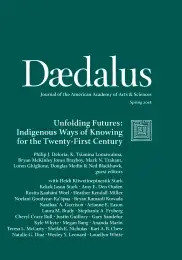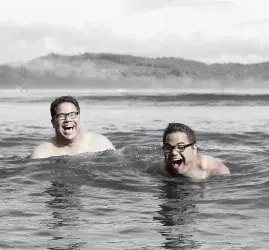

Unfolding Futures: Indigenous Ways of Knowing for the Twenty-First Century
Indigenous peoples are crafting a new environmental-social-political alliance and new strategies for political action, while simultaneously being written out of much of contemporary life. Begun at the height of the protests at Standing Rock, this issue of Dædalus aims to understand the contemporary dynamics of this modern racism; to create positive change in academia, the legal system, among government and nonprofit actors, and the intellectual and cultural life of the nation; to make “unknown unknowns” visible to non-Native audiences; and to speak to the unique status, honest challenges, and achievements of contemporary Indian people.
Nenabozho Goes Fishing: A Sovereignty Story
Drawing on the experiences of the Lake Superior and Mississippi Bands of Ojibwe, this essay explores how sovereignty has been debated and defined, from treaty-making practices with the United States to subsequent struggles for recognition of sovereign authority. Heidi Kiiwetinepinesiik Stark and Kekek Jason Stark find that the courts and Congress have oscillated between protecting and diminishing Indigenous nations’ abilities to exercise sovereignty and argue that, rather than a rights-based approach to sovereignty, a relational paradigm foregrounds responsibilities to one another and to creation, sustaining us all.
Recognition, Antiracism & Indigenous Futures: A View from Connecticut
The early 1970s were a moment of particular historical significance in Connecticut’s tribal nations’ centuries-long struggles to assert sovereignty and defend reservation lands. The racialization of Native peoples in Connecticut informed the state’s management of “Indian affairs” and its antirecognition policy reflects a long history of institutionally embedded racist policies and practices. Amy E. Den Ouden uses Connecticut as a case study to call for politically engaged, antiracist research that is concerned with understanding the complexities of tribal sovereignty in local contexts in which governmental control of Indian affairs reproduces and validates white supremacist ideology.
Alaska’s Conflicting Objectives
The treaty-making period between the U.S. government and Native peoples ended in 1871, four years after the United States purchased Alaska from Russia. Thus, Alaska Natives did not enter into treaties recognizing their political authority or land rights, nor were they granted the same land rights as other federally recognized tribes. Rather, Congress created the Alaska Native Corporations to manage reserved lands in 1971. Rosita Kaaháni Worl and Heather Kendall-Miller explore the unique legal status of these corporations: though created to settle land claims and assimilate Alaska Natives, Alaska Native cultures and governance structures persisted and evolved and, today, many are reasserting the inherent authority of sovereign governments.
Making ‘Aha: Independent Hawaiian Pasts, Presents & Futures
In 2014, hundreds of Kānaka Maoli (Native Hawaiian) came forward to assert unbroken Hawaiian sovereignty and reject a U.S. Department of Interior proposal that paved the way for federal recognition of a reorganized Native Hawaiian governing entity. Using Hawaiian methods of knowledge production to weave together contemporary and historical instances of Kānaka political resistance to U.S. imperialism and settler colonialism, Noelani Goodyear-Ka‘ōpua and Bryan Kamaoli Kuwada situate testimonies from these hearings within a longer genealogy of Kānaka assertions of ea (sovereignty, life, breath) against the prolonged U.S. military occupation of Hawai‘i.
Genetic Ancestry Testing with Tribes: Ethics, Identity & Health Implications
Genetic ancestry tests have been used to verify or dispute family stories about ancestors, to seek belonging with a particular tribe or community, and to identify genetic variants across populations in medical research. But assumptions about genetic testing – and the very idea of a “genetic” identity – pose challenges for communities defined in terms of political, social, and cultural identities. Nanibaa’ A. Garrison explores the potential implications of ancestry tests for Native American tribes and communities and concludes that, while their scientific and recreational use continues to increase, limitations of consistency across platforms and the generalizability of knowledge remain.
Reclaiming Representations & Interrupting the Cycle of Bias Against Native Americans
Representations of Native Americans are largely negative, antiquated, and limiting. The prevalence of such portrayals and a comparative lack of positive ones foster a cycle of bias perpetuating disparities among Native Americans with respect to other populations. Arianne E. Eason, Laura M. Brady, and Stephanie A. Fryberg illustrate how the legal system, the media, and education can be leveraged to promote positive conceptions of Native Americans, creating more equitable outcomes. The actions of some contemporary Native Americans to reclaim their Native American identity and create accurate ideas of who Native Americans are and what they can become provide a blueprint for leveraging cultural change to interrupt the cycle of bias and to reduce disparities.
Why Don’t More Indians Do Better in School? The Battle between U.S. Schooling & American Indian/Alaska Native Education
American Indian/Alaska Native education has been locked in battle for centuries with colonial schooling. Settler societies have used schools to “civilize” Indigenous peoples and to train Native peoples in subservience while dispossessing them of land. In the last century, Native nations, communities, parents, and students have fought to maintain heritage languages and cultures through Indigenous education and have demanded radical changes in schools. Bryan McKinley Jones Brayboy and K. Tsianina Lomawaima demonstrate that contemporary models of educators braiding together Indigenous education and Indigenous schooling better serve Native peoples to provide dynamic and productive possibilities for the future.
Revolution in Higher Education: Identity & Cultural Beliefs Inspire Tribal Colleges & Universities
Public institutions are accountable to the taxpayer and thus demonstrate their return on investment by measuring graduation rates, cost per student, job placement rates, and income. But Tribal Colleges and Universities (TCUs) are indebted to and inspired by the revolutionary vision of their founders, who believed that higher education rooted in tribal sovereignty, identity, systems, and beliefs would ensure the survival and prosperity of their people. Cheryl Crazy Bull and Justin Guillory assert that TCUs are advancing Native student access and completion, developing community-based research, and promoting economic and entrepreneurial development in tribal communities.
The New World of the Indigenous Museum
Museums have long offered simplistic representations of American Indians, even as they served as repositories for Indigenous human remains and cultural patrimony. Philip J. Deloria indicates two critical interventions – the founding of the National Museum of the American Indian (1989) and the passage of the Native American Graves Protection and Repatriation Act (1990) – that helped transform museum practice. The decades following this legislation saw an explosion of tribal museums and an increase in tribal capacity in both repatriation and cultural affairs. The NMAI, for one, explicitly argues for Native people’s centrality in the American story and insists not only on survival narratives, but also on Indigenous futurity.
The Story of Indian Health is Complicated by History, Shortages & Bouts of Excellence
One of the primary goals of the United States’ entry into health care was to protect soldiers by isolating and inoculating tribal populations from infectious disease. When tribes signed legally binding treaties, the United States promised doctors, nurses, facilities, and basic health care. Yet this promise has never been fully funded by Congress. Mark N. Trahant asserts that the Indian Health Service, which includes tribal and nonprofit health agencies, has largely failed American Indian and Alaska Native patients, despite the achievement of remarkable innovation and excellence.
Indigenous Leadership
Non-Native conceptions of Indian leadership are often marked by positive misunderstandings, negative misunderstandings, and general ignorance. Gary Sandefur and Philip J. Deloria, however, discuss the challenges surrounding American Indian leadership in the contemporary world, considering leadership issues in institutional settings such as academia, tribal governments, pan/inter-Indian organizations, public interest and NGO groups, and global Indigenous structures, and suggest ways in which non-Native organizations can better recognize, respect, and partner with American Indian leaders.
Critical Investigations of Resilience: A Brief Introduction to Indigenous Environmental Studies & Sciences
Indigenous peoples are among the most active environmentalists in the world, working through advocacy, educational programs, and research. The emerging field of Indigenous Environmental Studies and Sciences (IESS) is distinctive, investigating social resilience to environmental change through the research lens of how moral relationships are organized in societies. Kyle Whyte examines IESS research across three of these moral relationships–responsibility, spirituality, and justice–and argues that IESS can support Indigenous peoples’ struggles with environmental justice and political reconciliation; make significant contributions to global discussions about the relationship between human behavior and the environment; and speak directly to Indigenous liberation as well as justice issues that impact everyone.
If Indigenous Peoples Stand with the Sciences, Will Scientists Stand with Us?
Indigenous sciences – based in relationships, reciprocity, and responsibilities – constitute distinct perspectives on and practices of knowledge creation and decision-making that not only have the right to be pursued on their own terms, but may also be vital in solving twenty-first-century challenges. “Science,” and Western science in particular, is often treated as if it were a single entity, free of cultural influences and value-neutral. Megan Bang, Ananda Marin, and Douglas Medin argue for engagement with multiple perspectives on science and share empirical examples of how Indigenous sciences, sometimes in partnership with Western science, have led to new discoveries and insights into human learning and development.
Hear Our Languages, Hear Our Voices: Storywork as Theory & Praxis in Indigenous-Language Reclamation
Storywork – first-hand narratives through which language reclamation is described and practiced – provides data and insight on the meaning of language reclamation in diverse Indigenous communities. Teresa L. McCarty, Sheilah E. Nicholas, Kari A. B. Chew, Natalie G. Diaz, Wesley Y. Leonard, and Louellyn White argue that language reclamation is about voice, encapsulating personal and communal agency and the expression of Indigenous identities, belonging, and responsibility to self and community. The authors use their own storytelling to show that language reclamation simultaneously refuses the dispossession of Indigenous ways of knowing and re-fuses past, present, and future generations in projects of cultural continuance.